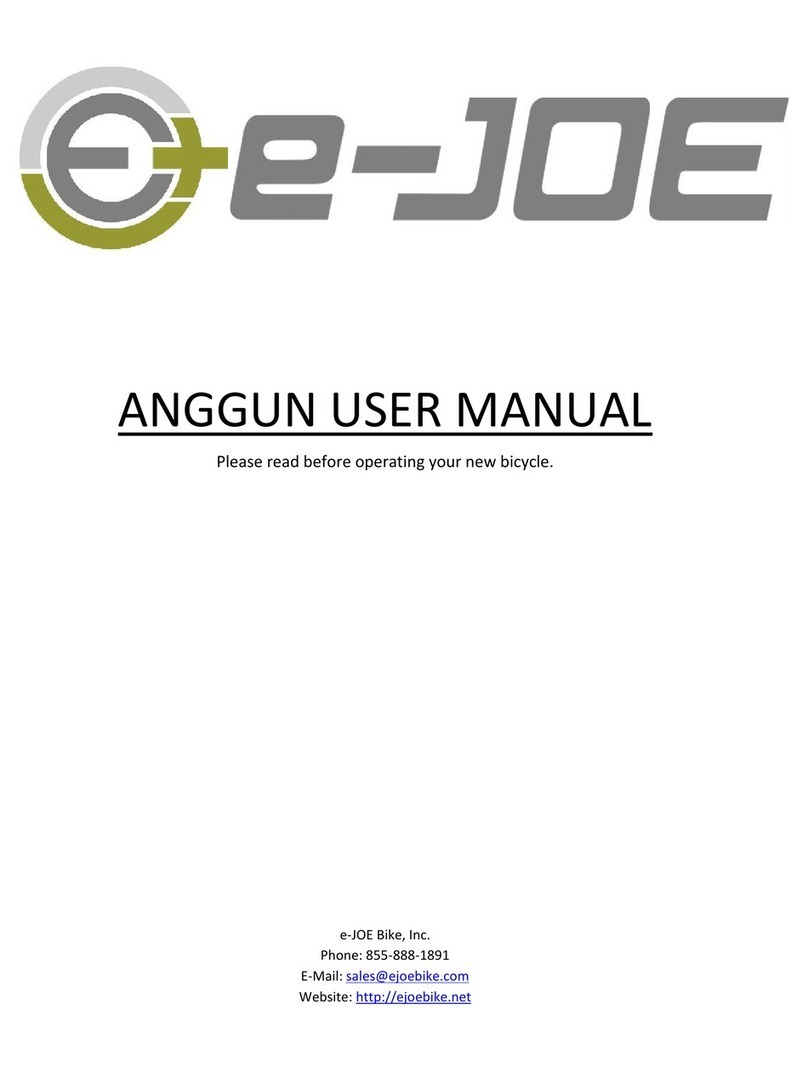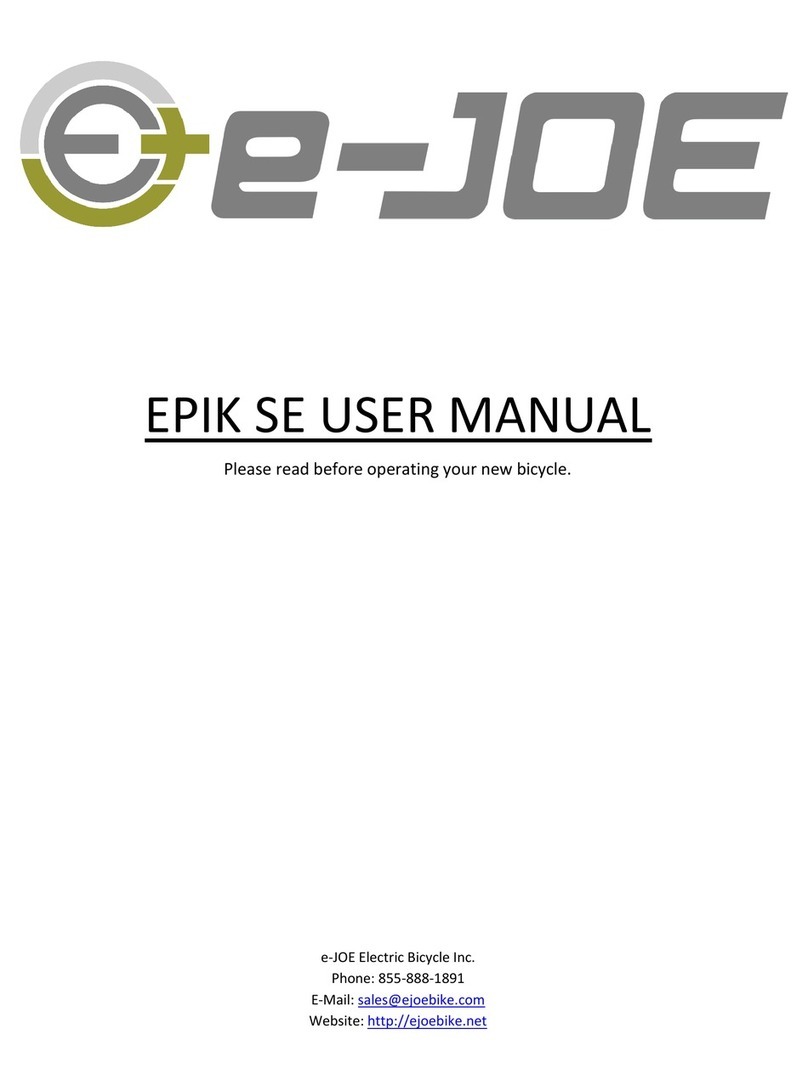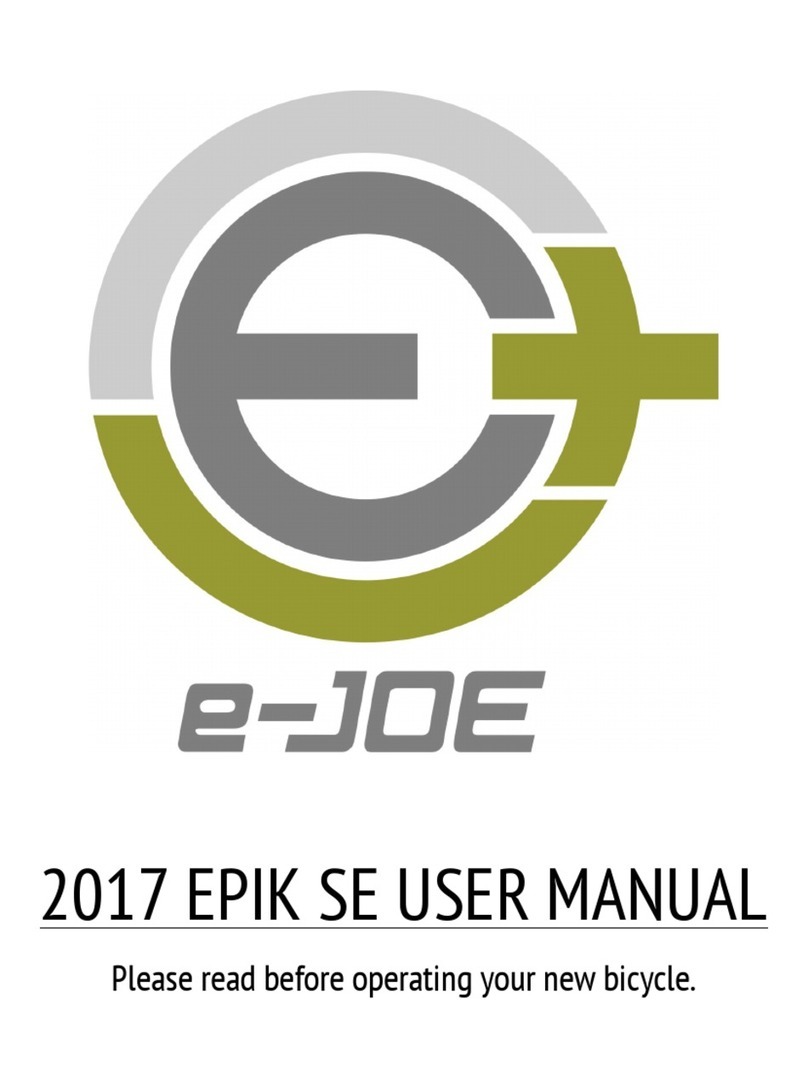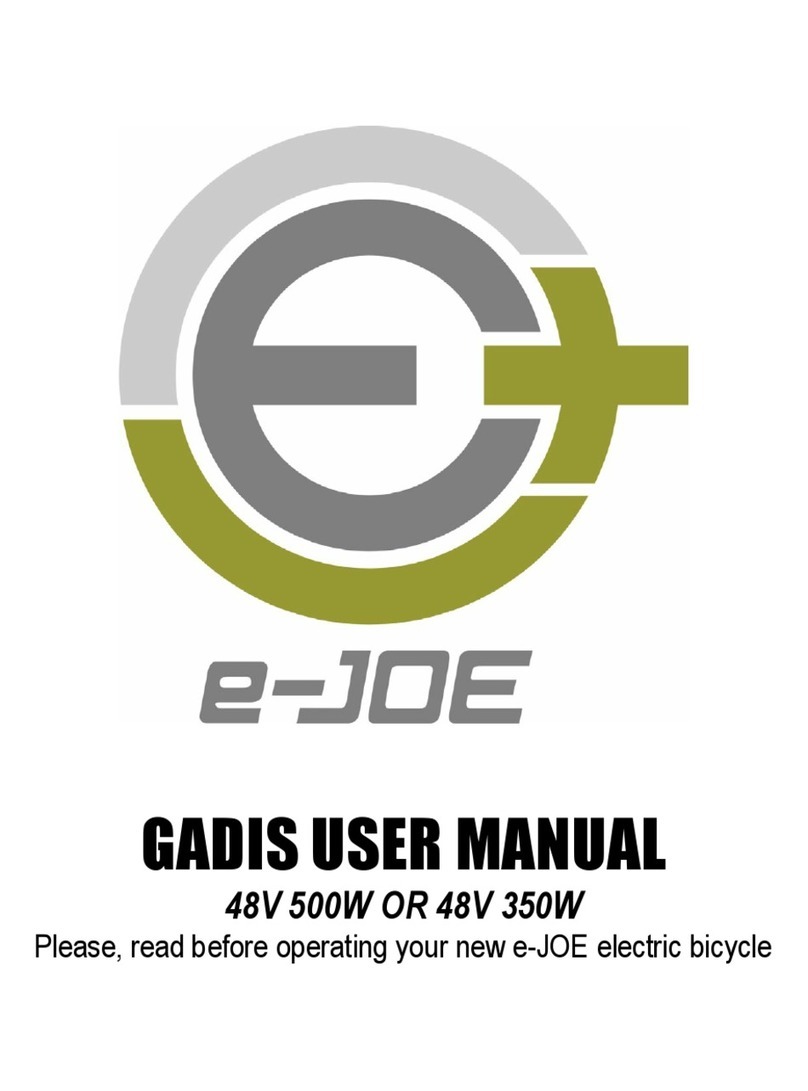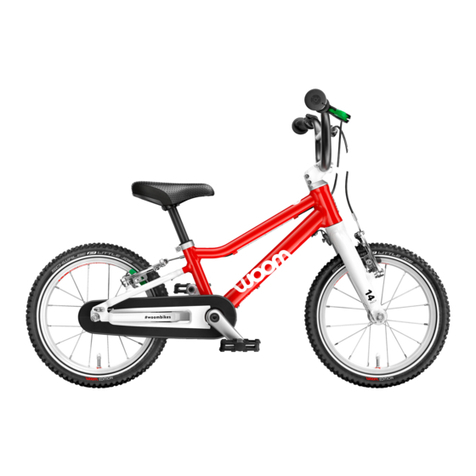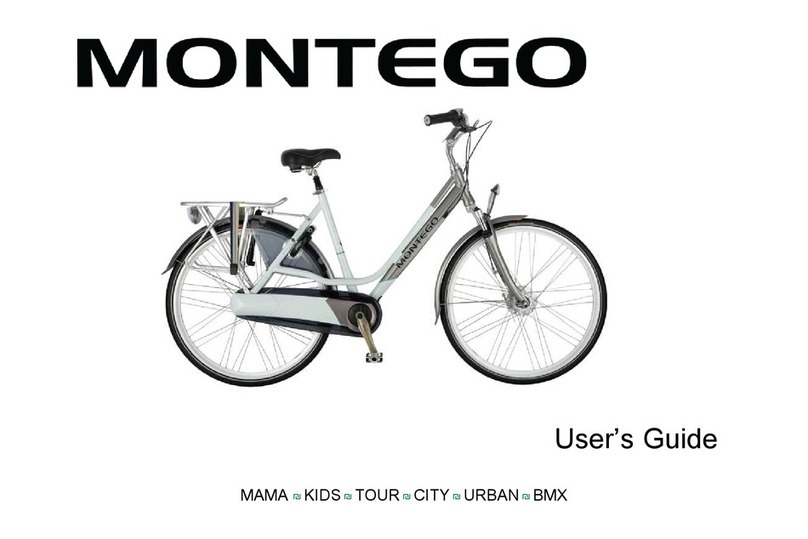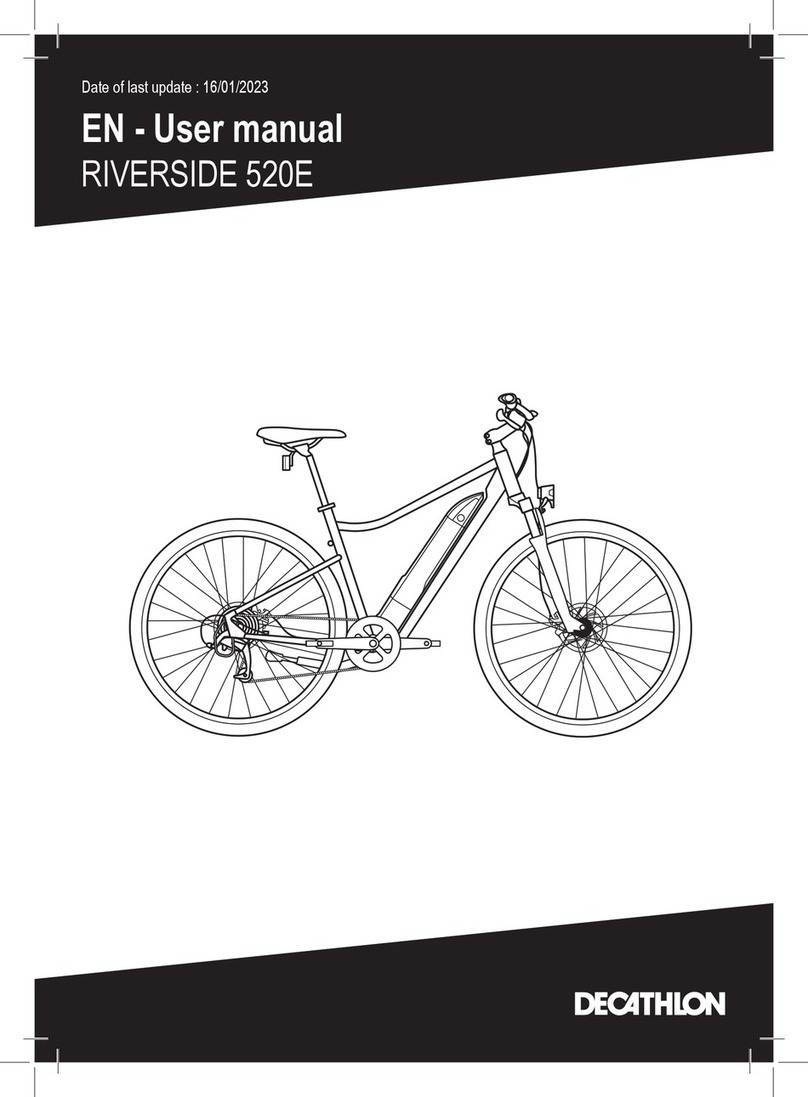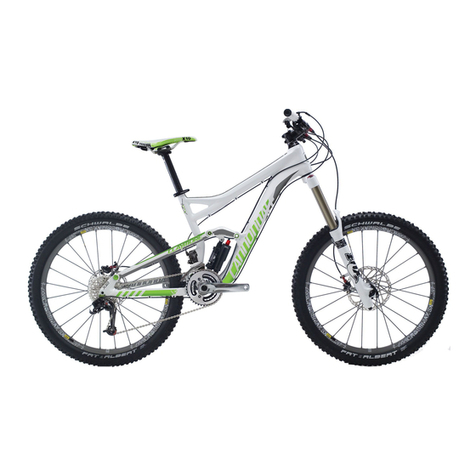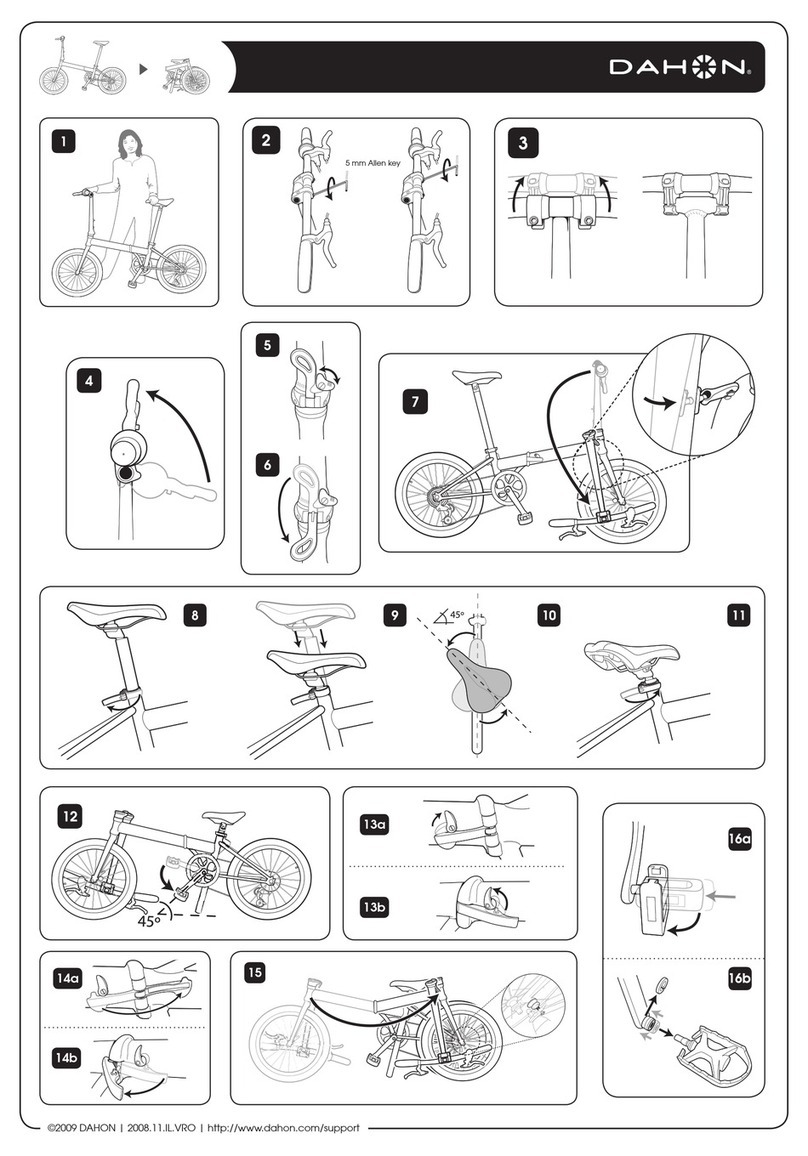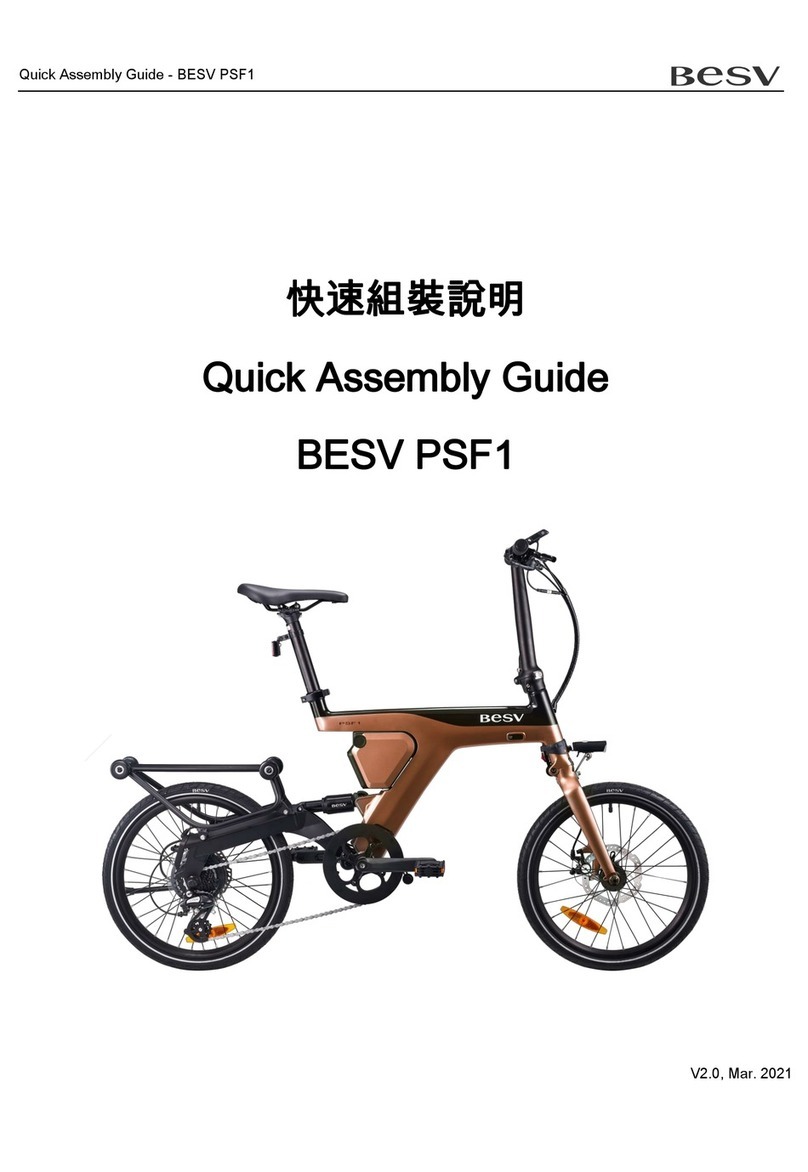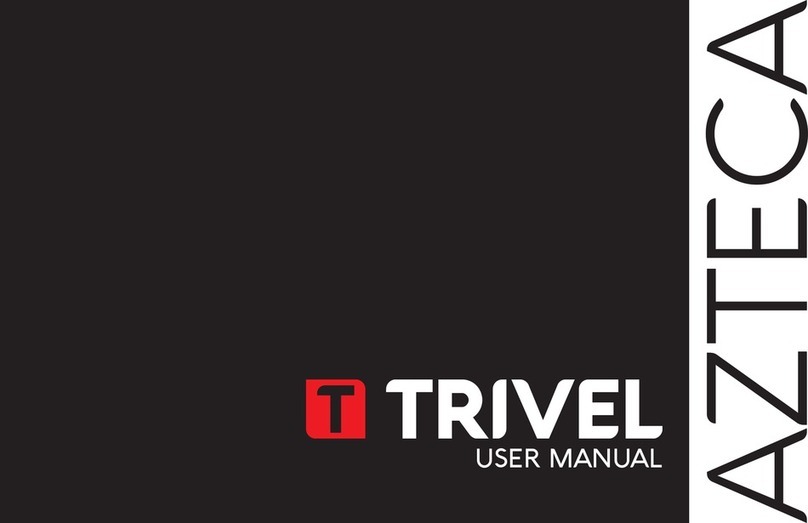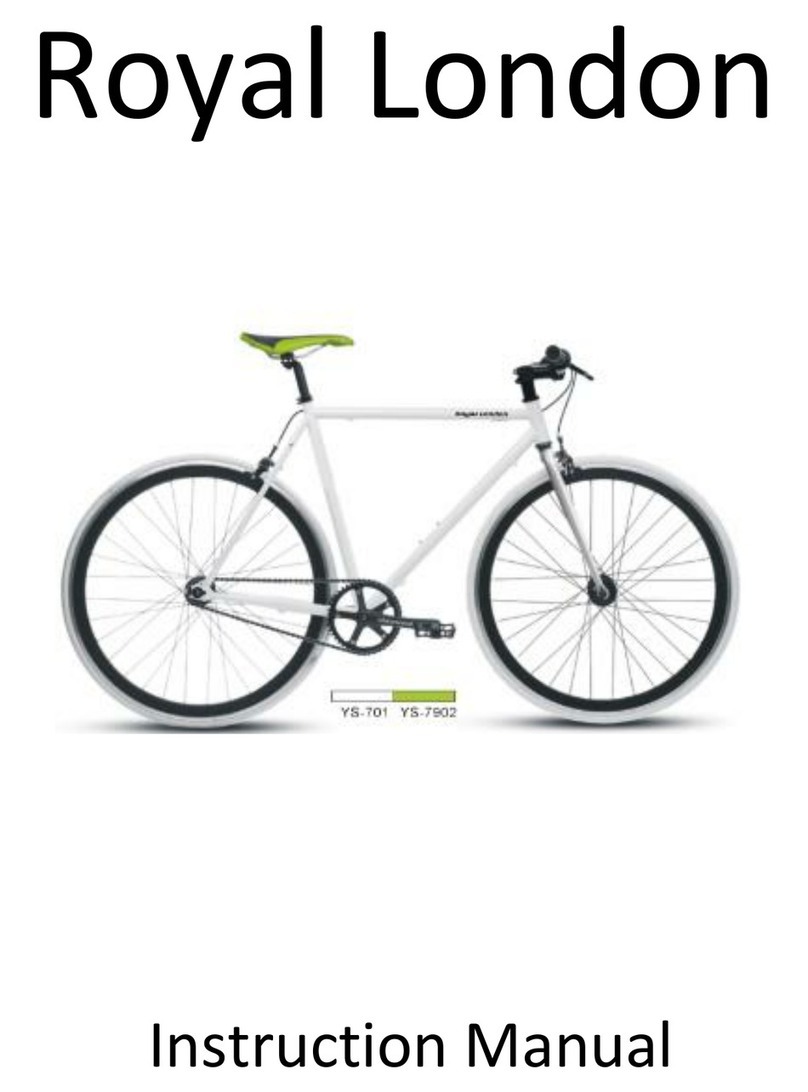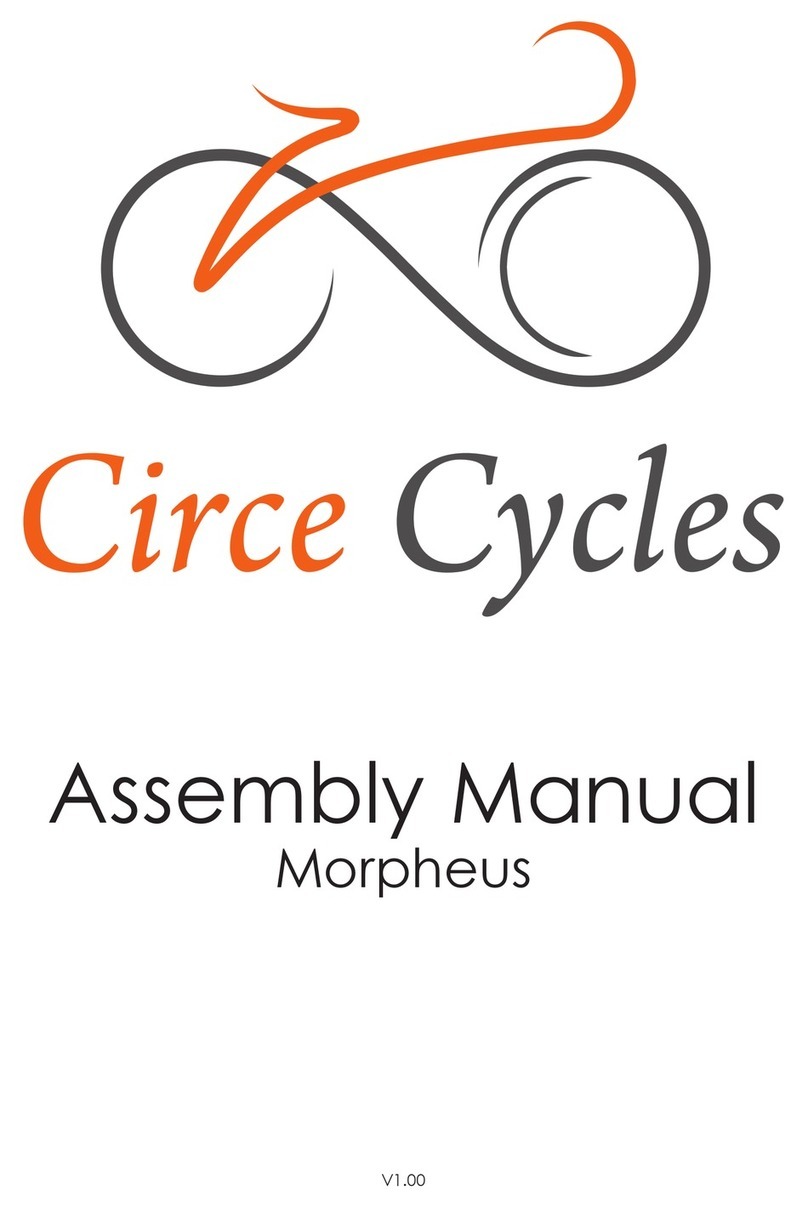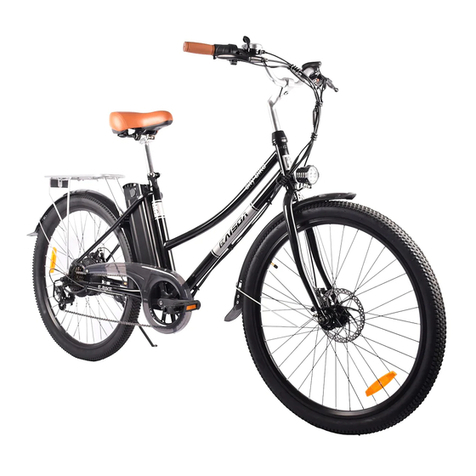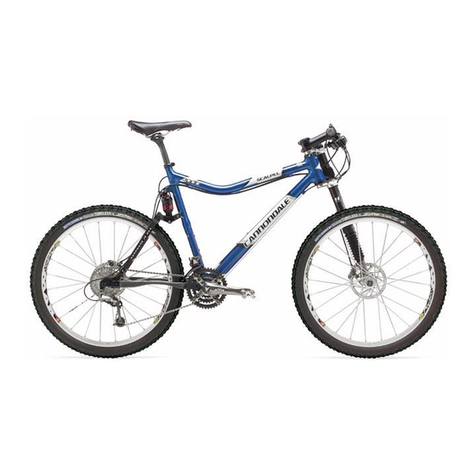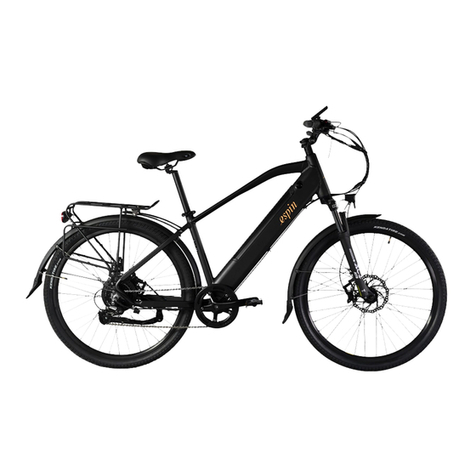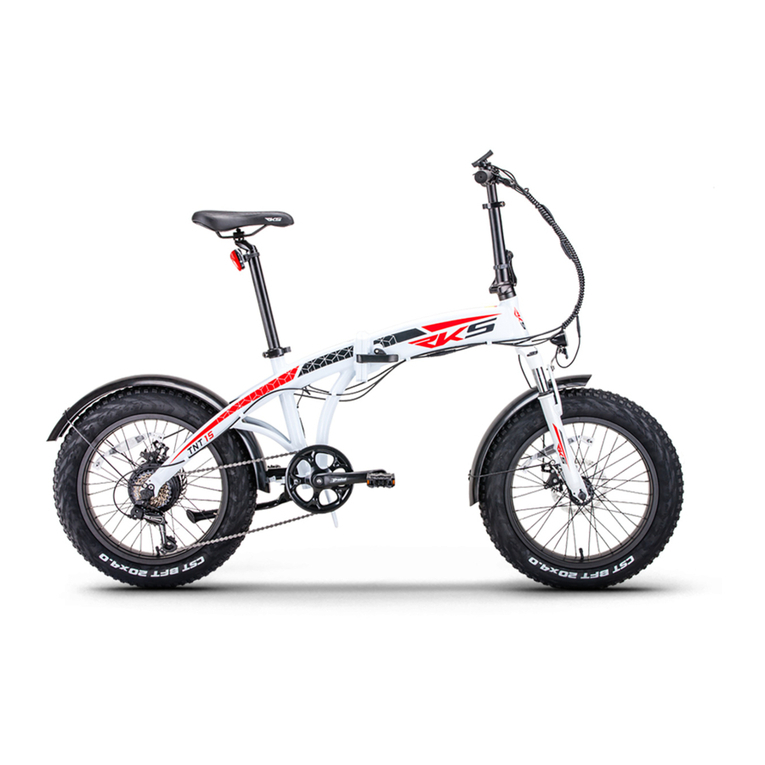e-Joe EPIK SWAN User manual

EPIK SWAN USER MANUAL
48V 500W OR 48V 350W
Please, read before operating your new e-JOE electric bicycle

2
INTRODUCTION
Congratulations on the purchase of your new e-JOE electric bicycle! We want to make you happy and believe your new e-
bike will bring you lots of fun.
We ask that you, please, read this manual thoroughly, paying particular attention to the safety warnings before you start
riding your bicycle.
Please, observe traffic regulations and do not lend your bicycle to anyone unfamiliar with it. It can only be legally used on
the road by a person aged 14 years and older. e-JOE bikes are not designed for use by children. If you decide to use a child
carrier, a child must be wearing a helmet and seated by the carrier manual.
We strongly advise wearing a bicycle helmet at all times when using your e-bike. If you are unfamiliar with cycling, we
suggest taking a cycling proficiency course before using your bicycle.
Remember that this manual makes no representations about the safe use of bicycles under all conditions. There are risks
associated with the use of any bike which cannot be predicted or avoided, and which are the sole responsibility of the rider.
Before you ride your bike for the first time, please, make sure it is correctly assembled. You can do this either by taking it to
your nearest bicycle shop or by inspecting it yourself if you are proficient in bicycle mechanics. You must make sure you
have the pedals, saddle, handlebar, and other items correctly fitted.
Test your brakes every time before using the bicycle and remember the bicycle will not stop as quickly in wet or icy
conditions as it would on a dry road.
Frequently check your tire pressure. The required tire pressure level is indicated on the side of each tire. Low tire pressure
will result in damage to the tires and will massively reduce your speed and range.
NEVER drink alcohol and ride your electric bike. The use of alcohol significantly reduces reflexes and limits your ability to
ride safely. Even a small amount of alcohol limits your ability to be safe on the road.
Please, note that small details or components may variate as we continuously update our product throughout the year. This
does not affect basic installation and assembly.
e-JOE cares for the environment and encourages its customers to dispose of e-JOE products per local regulations. When
you need to dispose of a lithium-ion battery, please, either dispose of the unwanted battery through an approved recycler or
send it back to us and we will make sure it is properly recycled.
Happy cycling!
YOUR FRIENDS AT E-JOE BIKE

3
OPENING YOUR BICYCLE
EPIK SWAN low step-through folding electric bicycle is shipped 98% assembled in a box that contains the following items:
●Main body of the electric bike consisting of:
○Frame
○Front wheel with a front suspension fork
○Rear wheel
○Tires & tubes installed and partially inflated
○Drivetrain
○Brake and shifter systems
○Handlebar subassembly (connected to the main body by the brake/shifter cables and electrical wires)
•Electric System consisting of:
oBattery (inside the frame)
oRear hub motor
oLCD Power Assist Display
oThumb Throttle
oPedal Assist Sensor
oInternal controller (inside the frame)
oWire harnesses
●Seat (or saddle) attached to the pedestal stem
●Fenders with supports
●Front and rear LED lights (integrated, powered by the main li-ion battery)
●Kickstand
●Rear rack (max load 15 kg)
●Pedals (2)
●Battery charger (in a separate box)
●Battery keys (2)
After unpacking, please, do not discard the box and protective material until you test the bike and make sure it is in good
working condition. Should you discover missing items, concealed loss or damage, report it to your dealer immediately.

STRUCTURE OF YOUR E-BIKE
NOTE: You can find the serial number on the head tube of the frame above the front suspension fork. The regular format is EJSW12345.
The removable battery and controller are located inside the frame.

2
SIZING

MAIN SPECIFICATIONS
BIKE
Weight (incl. battery)
45-50 lbs. (depending on bike configuration)
Max Capacity
300 lbs.
Dimensions (LxWxH)
Unfolded: L62” x W25” x H45”; Folded: L32” x W22” x H29”
Max Speed
20 mph
Full Charge Distance
up to 40 miles (depending on terrain and rider’s weight)
Climbing Grade
≤ 10%
Pedal Assist System
Thumb Throttle Control & 5 Level Pedal Assist
Frame
Aluminum Alloy Frame Low Step-Thru Foldable Design
Wheels
20” Standard Steel With Spokes, OR 20” Magnesium Alloy Wheels
Tires
20” x 2.125” K-924 Kenda Puncture Resistant
Seat
Velo Seat With Enhanced Shock Absorption And Enhanced Shock Absorption
Brakes
Front/Rear: TEKTRO 180 Rotor Disc Brakes
Gearing
7-speed Shimano Tourney, Thumb Shifter
Accessories
LCD Display, Fenders, Rear Rack (max load 33 lbs), Integrated Front/Rear LED Lights
MOTOR
Description / Power
BAFANG 500W Rated with 860W Peak Rear Brushless Geared Hub Motor, OR
BAFANG 350W Rated with 530W Peak Rear Brushless Geared Hub Motor
Max Riding Noise
60 dB
Rated Efficiency
80%
BATTERY
Type
Samsung 18650-Cells Lithium Ion
Voltage
48V
Capacity
11 A
CHARGER
Input Voltage
110-220 V
Charging Time
4-6 hrs.
How to Charge
Direct charge: Connect a plug with a plug receptacle

2
ASSEMBLY
NOTICE: The following assembly steps are only a general guide to assist in the assembly of your e-JOE Bike and are not a complete or comprehensive
manual of all aspects of assembly, maintenance, and repair. We recommend you consult a certified bicycle mechanic to assist in the assembly, repair,
and maintenance of your bicycle.
EPIK SWAN is shipped 98% assembled. To fully assemble the bike and prepare it for the first use, follow these steps:
STEP 1: UNPACK
•Place the box on the floor as per “This Side Up” sign on the side of the box.
•Prepare the following tools: scissors/cutter, adjustable wrench, and hex key set.
•Open the box by cutting protective tape or straps. If the box has staples on the top fold, be cautious when opening
as they may be sharp.
•Remove the bike out of the box by holding onto the frame (in case the bike is too heavy to pull out of the box, ask
someone for assistance).
•Stand the main body of the electric bike on a kickstand.
•Remove all protective material. Be extra careful when working with the scissors/cutter to avoid scratches.
NOTE: Do not discard the box or any shipping material until you test the bike and make sure it is in good working order.
STEP 2: INSTAL HANDLEBAR & SEAT
With the bike resting on the kickstand, unfold the folding pipe and lock it as shown on page 11. Make sure the folding pipe
locking lever is tightened, and the safety clip ring is in place.
Follow instructions on page 10 to adjust the handlebar position and height. Adjust the seat height. Make sure the quick-
release clamps are properly tightened.
STEP 3: INSTALL PEDALS & INFLATE TIRES
To attach pedals, begin by identifying the right and left pedals. Look for “L” and “R”
marking on the axles, wrench flats, or stickers. If you do not see “L” and “R” markings,
use pedal thread direction to identify pedals. Left threaded pedals (threads sloping
upward to the left) go to the left crank. Right threaded pedals (threads sloping upward to
the right) go to the right crank. See the image if in doubt (Left: left-hand threads on the
left pedal. Right: right-hand threads on the right pedal).
Be sure to grease the pedal threads before installation. Choose the appropriate pedal
and start it into the correct crank arm by hand turning the pedal axle toward the front of the bike (both pedals thread in this
direction). If it does not start, do not force it! You are probably trying to install the left pedal on the right side or vice versa.
Thread both pedals into the crank arms as far as you can by hand. Then fully tighten them with a wrench, so they do not
loosen from pedal pressure. Be careful NOT to overtighten the pedals as it may cause difficulties with their removal in the
future.
Inflate the tires to the proper pressure. You can find the information about the required tire pressure level on the side of each
tire. Make sure to check the pressure before each ride as low tire pressure results in damage to the tires and massively
reduces speed and range.

3
STEP 4: FINAL PRE-RIDE CHECK
•Check all nuts and bolts and make sure they are properly tightened, paying particular attention to the front wheel
axle nuts, rear wheel axle nuts, kickstand, yoke, and steering head bearings.
•Check the folding lever for the frame (see page 11 for more details).
•Check the folding lever for the handlebar pipe.
•Test the brakes.
•The battery is pre-installed inside the frame. Make sure it is properly locked in the frame. Lock it with a provided key
— place keys in a safe spot.
•Turn on the LCD Display on the handlebar as per instructions on pages 3-5. Make sure the battery is fully charged,
wear a helmet and… continue reading this manual thoroughly, paying particular attention to the safety warnings
before you start riding your bicycle.
For your safety you need to understand how things work on your bicycle and make certain, all parts are correctly assembled.
We urge you to consult your dealer before the first use and have your dealer check your work before you ride the bike. If you
have even the slightest doubt about your knowledge or bike’s assembly, talk to your dealer.
LCD
EPIK SWAN comes with the multifunctional LCD power assist display. The display is mounted on the left side of the
handlebar and has three main buttons (SW/UP/DOWN), and a monitor.
ON/OFF
By clicking on the SW button for a couple of seconds, the display turns on and activates the power supply. To turn off the
display and deactivate power supply to the bike, long press SW button down. When the bike is not in operation, and no
buttons are pressed for 5 minutes, the display will automatically turn off.
DISPLAY CONTENT
Various display content can be accessed by switching between 3 interfaces (see below). To switch from interface 1 to 2,
click the SW button once. Repeat the action to switch from interface 2 to 3, or to return from interface 3 to 1. In each
interface, if you long press SW button, the LCD and overall power to the bike turn off.

4
INTERFACE 1
INTERFACE 2
In the riding mode, after 5 seconds interface 2 switches to interface 1.
INTERFACE 3
In the riding mode, after 5 seconds Single Maximum Speed (MXS) returns to Real Time Speed.
Single Trip Distance
DST (in km/h or mph)
Battery Capacity
Brakes
(when applied)
Single Trip Time
(TM)
PAS Level
Real Time Speed
(in km/h or mph)
Backlight/Headlight
(when in use)
Walk Power Assist
(when in use)
Cruise, PAS, Throttle
(when in use)
Total Trip Distance
ODO (in km/h or mph)
Battery Capacity
Brakes
(when applied)
Total Trip Time
(TTM)
PAS Level
Single Average Speed
AVS (in km/h or mph)
Backlight/Headlight
(when in use)
Walk Power Assist
(when in use)
Cruise, PAS, Throttle
(when in use)
Real Time Voltage VOL
Battery Capacity
Brakes
(when applied)
Total Trip Time
(TTM)
PAS Level
Single Maximum Speed
MXS (in km/h or mph)
Backlight/Headlight
(when in use)
Walk Power Assist
(when in use)
Cruise, PAS, Throttle
(when in use)

5
Pedal Assist System (PAS) – Level selection
PAS comes with 5 levels of pedal assistance. There is no pedal assistance when
the level is set to 0. To change the PAS level, click UP or DOWN button to increase
or decrease the levels.
Every time you turn on LCD, it will automatically restore the most recent level. For
your safety and to avoid accidental use of the throttle, make sure to keep the PAS
on level 0 at all times when the bike is not in use.
Walk Power Assist
Riders can use up to 6 km/h power assist function when pushing bikes. Hold button
(DOWN), the Walk Power Assist function logo flashes and the bike moves at the
speed of no more than 6 km/h. Release button (DOWN), the assist function will be
revoked.
Backlight and Headlight
Hold button (UP) for a couple of seconds to turn on the backlights as well as the
headlights. The lights indicator turns on when the lights are on. Hold button (UP)
long again to turn off backlights and headlights.
Battery Capacity Indicator
When the battery is fully charged, the icon shows four full bars on the top left corner of the display. When the battery is
low on change, the indicator starts flashing.
Voltage shortage flashes
Single Data Clearing
5 seconds after the LCD is powered on, at interface 1, hold both the button (UP)
and the button (DOWN) simultaneously for about 2 seconds, the single trip time
(TM) and single trip distance (DST) flash, then hold button shortly (SW), the record
contents of both will be cleared.
When the data is flashing, if there is no operation on the data within 5 seconds, the
LCD will automatically return to interface 1, and the original content will be saved.
Error Code Definition
When the electric control system of the bike is out of order, the display automatically
displays the error code and stops working correctly. The reason for the error is
shown in the error code definition table below.
Error Code
Def
i
nition
01_info
Throttle abnormality
03_info
Motor hall signal abnormality
04_info
PAS Sensor signal abnormality
05_info
Axis speed sensor abnormality (only applies to torque system)
06_info
Motor or controller abnormality

6
FAQ
Why does the display not turn on? Check the connections between the display wire harness and the controller. Make sure the
battery is charged.
The display shows an error. What to do? The error code will disappear once the issue associated with it is resolved. Check
bicycle components and wires for any signs of damage. Disconnect and re-connect main wire harness at the handlebar,
recharge battery, and check LCD again. Contact your dealer for further instructions.
For more information about the display and its settings, visit the official LCD manual.
THROTTLE
EPIK SWAN is equipped with a throttle that allows to speed up to 20 mph without pedaling at all. The thumb throttle is
mounted on the right side of the handlebar.
The throttle is activated starting from PAS level 1. It will not engage the motor with PAS level 0. To use the throttle, slowly
press its lever with your thumb to apply power to the motor. The throttle provides smooth acceleration when applied
gradually.
The throttle mechanism allows full power to be activated from a stop, and inexperienced users should take extra care when
first applying the throttle. We recommend beginning the ride with pedaling first and then applying the throttle.
Always be aware of your surroundings. Do not use the throttle unless you are on the bike. As a precaution, switch PAS level
to 0 or turn off the LCD after riding to avoid accidental activating of the throttle or PAS.
PEDAL ASSIST SYSTEM (PAS)
A pedal assistance feature is a powerful option, and users must understand how to operate it before the first ride.
EPIK SWAN offers five levels of cadence PAS. The cadence sensor is attached to the bottom bracket behind the pedal
crank arm. Switching from level 0 to 1 activates the pedal assist sensor. As soon as the pedals start rotating (with PAS level
1-5), the sensor catches the signal and turns on the motor to provide a cyclist with an appropriate amount of power. The
higher the level of PAS, the more power it provides. The electric motor assists up to 20 mph and cuts out if pedaling faster
than that.
It is recommended to pedal the bicycle with the Pedal Assist System mode ON, choose appropriate gear, refrain from
unnecessary braking, and coast as much as possible. When riding your e-bike with the low battery power, it is
recommended to pedal your e-bike as much as possible and get the battery charged up as soon as you get to an electrical
outlet.
As a precaution, switch PAS level to 0 or turn off the LCD after riding to avoid accidental activating of the throttle or PAS.

7
BATTERY & CHARGER
BATTERY
EPIK SWAN is delivered with the battery pre-installed inside the frame and
partially charged. A charger is shipped in a separate box. A unique set of keys is
provided. A spring lock keeps the battery in place and provides safety from theft.
The battery is removable and can be charged either inside or outside of the
frame. To remove it, insert the key into the lock and turn it counter clockwise until
the top portion of the battery pops out of the frame. When installing the battery back into the frame, do not force it in. Slowly
insert the battery while making sure it is correctly seated against its housing in the frame. Push the top portion of the battery
until the spring lock clicks and secures the battery in place.
NOTE: The keys are to unlock the battery only. Turning the key DOES NOT act as the ignition for the battery or motor. Keep
in mind that e-JOE does not carry copies of the keys. It is recommended to store one key in a safe location in case the first
key is lost.
To check the battery charge level, long press the button on the battery until the color light up (green = top charge, red = low
charge, or blue = mid charge) or use the charge indicator on the LCD Display.
BATTERY CHARGER
Always use the charger provided by e-JOE for your specific bicycle and battery
type. The charger works on 110/220V 50/60Hz standard home AC power outlets. If
you plan on moving from the USA, double-check the charger specifications and the
local standards.
CHARGING PROCEDURE
1) Place the charger and battery indoors in a dry ventilated area away from
sunlight with the temperature 50-80F.
2) With the battery inside or outside of the frame, locate the charging port on
the left side at the top of the battery pack.
3) Connect the AC input plug into the outlet. The LED light on the charger
should turn GREEN (Charge).
4) Connect the DC output plug from the charger to the battery port. The LED
light on the charger should turn RED (Charge in the process).
5) When the battery is fully charged, the LED light on the charger should turn
GREEN (Fully Charged).
6) Unplug the charger from the battery first and then from the outlet.
While the charger automatically stops charging when the battery is full, we strongly recommend not to leave the battery
connected to the charger and outlet for a lengthy period. The average time for charging from low to full is approximately 4 to
6 hours. As the battery ages after 2-3 years of use, you may notice increased charging times and decreased range. If the
battery does not seem to be charging, as usual, discontinue charging/using it and contact e-JOE or dealer for assistance.

8
BASIC BATTERY CARE & MAINTENANCE
•Keep your lithium battery charged
Lithium batteries are generally best kept 80% charged. Do NOT use your battery in a very low state. Completely
discharging a lithium battery below safe levels can cause irreparable damage to the cells and diminish its capacity. If
you do "flatten" your battery, fully re-charge it as soon as possible. To prevent the battery from irreparable damage,
never leave a battery wholly depleted or drained.
•Keep your electric bike battery clean and dry
Contacts on the battery should be clean and dry to avoid oxidation and corrosion, which would weaken the ability of
the battery to power the bike. Check the contacts every few months.
•Keep your lithium batteries cool
The lithium battery is best stored in cool conditions. While storing batteries in cool conditions is good, always
remember to warm the battery to room temperature before charging or using it in the bike.
•Plan for long-term storage of your electric bike
If you know you are not going to use your battery for a few months, it is wise to take some extra precautions. To
reduce the loss of capacity over time, yet still preserve the battery, it is best to store it at about 80% charge. You can
estimate this by riding your e-bike for about 20% of the average distance with a fully-charged battery. It's best then
to store the battery in a cool well-ventilated place. To prevent premature failure of your battery and for the warranty
on your battery to remain in effect, it is recommended to charge the battery at least once per month.
IMPORTANT SAFETY WARNINGS!
●Connect the charger to the outlet first, and then to the battery. Connecting the unplugged charger directly to the
battery may create a spark.
●While charging, place the battery and charger in a secure place where children or pets cannot reach it.
●Avoid any contact with water while charging; prevent liquids, metal, and metal filings from permeating the charger.
●Do not put anything on top of the charger while charging; it must be well ventilated to allow the heat that is generated
to dissipate.
●Stop charging the battery immediately if you notice a peculiar smell or the charger gets too hot to touch.
●Do not touch the poles of the battery. The battery poles should not be touched with any other metal or other material
that conducts electricity.
●Be careful not to drop or hit the battery or the charger as it may damage its components.
●It is normal for the distance range to reduce as a result of cells aging or battery use in low or high temperatures.
●Do not attempt to open or repair your charger or battery. Doing so voids the warranty and can result in a safety
hazard. Contact your local e-JOE Bike Dealer or e-JOE technical support.
●When you need to dispose of a lithium-ion battery, either dispose of the unwanted battery through an approved
recycler or send it to e-JOE. We will make sure it is properly recycled.
●Never dispose of batteries in fire because they may explode.

9
BRAKES
EPIK SWAN has a mechanic disk brake system installed on both wheels, front and rear, to control the braking of the
bicycle. The system has an electrical cut-off function, an important safety feature of all e-JOE electric bikes. It disengages
the motor when the brake levers are squeezed. Therefore, it is critical to make sure the brake system works properly.
Brake Precautions
●Test your brakes every time before using the bicycle and remember the bicycle will not stop as quickly in wet or icy
conditions as it would on a dry road.
●The brake system requires regular cleaning, maintenance, and adjustment. Have your brakes inspected and
serviced regularly by an experienced mechanic (every six months to a year should be sufficient for occasional
cyclists). Take your bike in more often if you ride or use brakes frequently.
●Remember which wheel is controlled by which brake.
●Do not brake too strongly or abruptly, as it will make it easier for you to fall.
●Incline your body backward to reduce the influence of inertia.
●The brake system includes brake pads which gradually wear down due to normal use. When the brake pads wear
out, repair or replace them as soon as possible.
●Over time disc brakes lose some of their effectiveness. This leads to longer response times, less efficient braking,
and less bike control. If you start experiencing such issues, hear a squeaking noise when braking, lack stopping
power, refrain from using the bike and bring it to a local bike shop for inspection & service.
DRIVETRAIN & GEARS
The drivetrain of the bicycle consists of all parts that you use to push or pull the bike along. The key components are the
pedals, cranks, chain, freewheel, gear shifter, and rear derailleur.
Gears are there to enable you to maintain a comfortable pedaling speed (or cadence) regardless of the gradient or terrain
— something that single gear is not capable of.
EPIK SWAN comes with seven (7) gears. To change the gear while riding, press + or – of the shifter on the right side of the
handlebar until you reach your desired gear. The gears are switched by the rear derailleur located on the right side of the
rear wheel. The derailleur moves the chain up or down the freewheel setting it to the desired gear.
●The gear setting is displayed on the shifter. The higher the gear number, the more resistance is given when
pedaling.
●The combination of pedaling and gear effects the battery range when riding with pedal-assist. If you are riding uphill
or in the areas where it becomes difficult to pedal, shift to a lower gear. If you find that you are moving faster than
you can comfortably pedal, try moving to a higher gear. This will help conserve battery power and achieve
comfortable pedaling.
●It is easier to start riding if the bike is set to a lower gear.
●If you experience “skipping” of gears, noisy switching, bring the bike to an experienced mechanic for adjustment.
●Keeping your derailleur, chain, and freewheel clean, lubricated, and moving freely will expand their service life and
avoid costly repairs.
●If you need to service the pedals, follow instructions on page 3 for their removal and installation.

10
SEAT & HANDLEBAR
Appropriate adjustments can be made to seat (or saddle) & handlebar height according to personal preference.
QUICK-RELEASE CLAMP
The clamps that hold handlebar or seat posts in place are called quick-release clamps. If you need to tighten or loosen the
clamp, use an adjustment knob located on the opposite side from the quick-release lever. Open the lever and turn the
adjustment knob clockwise. As you tighten the adjustment knob, you'll be able to close the lever more securely. In case you
tighten the knob too much, you won't be able to close the lever at all. Repeat this process until you find a "happy medium"
point where the lever is tight enough to hold the post, but not so tight that you cannot close the lever all the way.
MAX MARK LINE
When adjusting the height of the seat or handlebar posts, it is forbidden to expose
the MAX mark line (also called, the safety line or infix notation). If used
inappropriately, it may cause serious injury to the rider.
SEAT HEIGHT ADJUSTMENT
Stand over the frame and sit on the saddle. Step on the pedal with your heel.
Rotate the pedal to its lowest position while straightening the leg. The height is best
suited when the leg is straightened out with a slightly bent knee. If the leg is
excessively bent, raise the seat. If your knee is fully extended, lower the seat.
To do so, unlatch quick-release lever on the seat tube and move vertical stem to appropriate height, making sure not to
exceed the safety MAX mark. Point the front tip of the seat towards the handlebar along the frame. Close the quick-release
lever while making sure it’s tight enough to keep the seat post in place.
SEAT POSITION ADJUSTMENT
The seat should be at a neutral position allowing the rider to sit on the middle portion of it without sliding forward onto the
nose or backward off the rear of the saddle. The seat position can be adjusted by loosening the seat clamp under the seat
and sliding the seat forward or backward. Be sure to loosen the clamp only enough to move the seat. You may need to test-
ride the bike with the new adjustment several times until you make sure this seat position is the most comfortable.
HANDLEBAR ADJUSTMENT
Similar to the seat, handlebar height can be adjusted to achieve a comfortable riding
position. To do so, unlatch quick-release lever on the folding pipe and move vertical
stem to appropriate height, making sure not to exceed the safety MAX mark.
If you wish to adjust handlebar position, loosen the top quick-release clamp in the
middle of the handlebar. Rotate the handlebars so that the brakes are at a 45-degree
angle to the ground. Tighten the lever.
Check to ensure the handlebar, handlebar folding pipe, and seat post are properly
fastened, aligned, and fitted to the user. Ensure all hardware securing the handlebar
and seat is properly tightened, including quick-release levers.
SEAT POST
MAX LINE
HANDLEBAR
POST MAX
LINE

11
FOLDING INSTRUCTIONS
FRAME
The frame locking lever is located in the mid portion on the right side of the frame. To unlock the lever and fold the frame,
slide the bottom lock towards the front of the bike and simultaneously pull the silver locking lever away from the frame.
When unfolding the frame, push the lever against the frame until the lock clicks and secures the frame.
WARNING! When unfolding the frame and locking the lever, always make sure the internal wires are out of the way!
PEDALS
Fold the pedals by pressing the end of the pedal inward and then upwards or downwards.
FOLDING PIPE
To unlock the pipe and fold it, locate the locking lever at the base
of the pipe. (1) Slide the safety clip ring out and away from the
lever; (2) pull the locking lever out and down towards the floor.
Complete the action by folding the pipe down at the hinge.
When unfolding the pipe, (1) unfold the pipe and align it with the
base. (2) Align the silver bolt with a round notch on the inner side
of the latch. (3) Pick up the lever and push it against the pipe until
it is safely locked. (4) Complete the action by inserting the safety
clip ring into or around the lever.
COMPLETE BIKE FOLDING PROCEDURE: 1) turn off the LCD, 2) fold kickstand along the frame; 3) fold both pedals, 4) lower
seat post to minimum or remove it completely, 5) fold handlebar folding pipe along front wheel, 6) fold frame, 7) stand bike on
stand (located under the bottom bracket/pedals), 8) (optional) use bungee cords to secure the bike from unfolding.

12
GENERAL OPERATION & MAINTENANCE
Like any other mean of transportation, electric bicycle and its components are subject to wear and tear. When comparing to
regular bicycles, the rate of wear for electric bikes is higher due to its weight and speed; it does not mean the components
are defective or of low quality. The rate of wear depends on the way of use (mileage, terrain, weather conditions, etc.), as well
as level of care and maintenance.
The use of a bicycle in competitive events, aggressive riding, riding on severe terrain/climates, riding with heavy loads,
commercial activities and other types of non-standard use can dramatically shorten the life of the bicycle and its components.
Be sure to use your bicycle for its intended purpose only.
●Always follow the instructions described throughout this manual and abide by local regulations.
●If you have the slightest doubt about your knowledge about the bicycle, its assembly or operation, visit the local
dealer.
●Have the bike inspected by a professional mechanic after the first 60 miles of riding and every 300 miles.
●Wheel spokes should be adjusted every 300 miles of riding.
●Keep your lithium battery charged, dry, and stored in cool conditions.
●Handlebar and saddle posts should never be raised beyond the maximum safety line around the tubes.
●Your bike has a rear derailleur that will automatically tension your chain. However, if the chain becomes loose or
frequently comes off the front cog, you can adjust the chain tension by loosening the rear axle nuts slightly and
adjusting the tension bolts. Make sure the chain runs freely and retighten the axle nuts.
●Disc brake calipers, rotors, and brake pads get extremely hot after bike use. Do not touch these parts after a ride and
be sure to allow some time for the brake system to cool down before attempting service.
●Head/back-lights, bell, and reflectors are important safety cycling devices. Check reflectors and their mounting
brackets regularly to make sure they are clean, straight, unbroken and securely mounted.
●Ensure handlebar grips are not damaged and properly installed. Loose/damaged grips can cause loss of control and
falling.
●In case you hear an unusual noise, experience “wobbly” motion of wheels, lack of braking power, intermittent pedal
assistance, or other unusual signs when operating the bicycle, stop using it and visit a local dealer for inspection.
●Leaving a bicycle standing in the open or not using it for long periods may be subject to increased wear through
weathering and deterioration. You should have your bicycle, and its components checked periodically by your dealer
for indicators of stress and potential failure, including cracks, corrosion, deformation, dents, paint peeling, and any
other indicators of potential problems, inappropriate use or abuse. These checks are important to ensure all
components function safely and reliably and to help prevent any accidents or injuries to the rider.
IMPORTANT! Do not attempt to open the casings of the battery, motor, or controller; it could be dangerous and will void any
warranties by doing so. If you experience a problem, please contact our service department or your local dealer.
WATER
•Your electric bicycle is rain and splash resistant. Please, use caution; do not operate your bicycle or leave outside
in bad weather conditions.
●The electric components, such as the LCD, motor, battery, and controller, MUST NOT be submerged in water.
●To prevent rust or corrosion, dry off bicycle and components after riding and store bike and battery in a dry location.
DO NOT turn on the bike after exposure to water. Dry it thoroughly first!
●To avoid electric shock and damage to your product, do not charge the battery while it is wet or in an area where it
could get wet. Do not handle a bicycle, charger, or cords with wet hands while charging.

13
WARRANTY
STANDARD LIMITED WARRANTY
e-JOE warrants every new e-JOE electric bicycle to be free from manufacturer defects in material and workmanship for ONE
(1) year provided that the product is used in a standard and controlled manner, and maintained according to its owner’s
manual.
This warranty is valid in the United States only and applies to the person or entity that originally purchased the product from
e-JOE or its authorized dealers in the United States (not transferable to a subsequent purchaser). The warranty period
commences upon the date of original purchase. Proof of purchase from an authorized e-JOE dealer and photo/video evidence
of the defect are required to receive the warranty support.
What is covered by this warranty?
e-JOE warrants every new e-JOE product against defects in material and workmanship as follows:
Limited ONE (1) Year Components Warranty
e-JOE electric bicycle: frame, suspension fork, stem, handlebar, headset, LCD display, seat post, saddle, brake levers, cables,
bottom bracket, crankset, pedals, chain, rims, wheel hub, freewheel, cassette, derailleur, calipers, shifter, brake discs/rotors,
brake/shifter cables, motor, throttle, controller, wiring harness, kickstand, grips, head and tail lights, rear rack, fenders,
reflectors, and hardware;
Limited ONE (1) Year Lithium-Ion Battery Warranty
Lithium-Ion batteries are warranted to be free from manufacturer defects in materials and workmanship for ONE (1) year
period from the date of original purchase. The battery warranty does not include damage from power surges, use of an
improper charger, improper maintenance, misuse, normal wear, or water damage.
Limited 30 Days Full Replacement Warranty
If an e-JOE product is not working properly because of a major manufacturer defect within the first 30 days of original purchase,
e-JOE Bike will repair or replace any defective product at its sole option and expense upon determining whether the damage,
failure, or loss is due to a major manufacturer defect. e-JOE will first issue replacement parts for a reasonable number of tries
(as determined by e-JOE). If the product does not function properly after the parts replacement attempts, e-JOE will send a
full replacement bicycle or scooter upon receipt and inspection of the original product and replacement parts.
e-JOE reserves the right to charge 10% of the product price in case the original product is returned in a bad manner, with the
insufficient protective material, not by the instructions provided by e-JOE, or shows signs of excessive use, neglect, dirt, dust.
A full replacement product will be issued only after such fee is paid in full.
Limited 7 DAYS Shipping Damages Coverage
e-JOE will repair or replace the parts damaged during shipping at its sole option provided that such damage is documented
on the bill of lading and reported to the dealer or e-JOE within the first seven days after delivery. It is the customer’s
responsibility to inspect the box and the product at the time of delivery, take pictures of any damage and keep all packaging
and paperwork until the damage claim process is complete.

14
What is NOT covered by this warranty?
•e-JOE product without presented proof of purchase from an authorized e-JOE dealer AND photo/video evidence of
the defect;
•e-JOE product purchased from an unauthorized e-JOE dealer;
•e-JOE product with an expired warranty period;
•e-JOE product transferred to a subsequent purchaser or owner;
•normal wear and tear (scrapes, scratches, etc.);
•consumables (components that are subject to a short life and periodic replacement due to their functions including,
but not limited to tires, tubes, brake pads, spokes, alkaline batteries, saddle covering, paint, mineral oil, other
lubricants);
•assembly or tune-up fees;
•costs associated with inspection, labor, packaging material, shipping of warranted products;
•damage or defects resulting from failure to follow instructions in the owner’s manual, improper assembly, use of
incompatible and non-original parts, improper maintenance, storage, and transportation, alterations, modifications,
acts of God, accidents, misuse, neglect, abuse, water damage, operator’s error, commercial activities, extreme or
excessive riding, and other types of non-standard use;
•damage or defects resulting from an attempted repair unless performed by an authorized e-JOE Dealer with e-
JOE’s knowledge and approval;
•damage or defects caused by flood, lightning, earthquake, war, vandalism, theft, brownouts or sags (damage due to
low voltage disturbances).
How to obtain warranty support?
Step 1
Make sure to have the following available: the original bill of sale with unexpired warranty period (proof of purchase),
photo/video evidence of the defective part or product, and main product information (such as model, serial number, battery
voltage, motor wattage).
Step 2
Read the respective manual and FAQs for troubleshooting and repair instructions. If the solution is not found, contact the
authorized e-JOE Bike dealer (seller) from whom you purchased your product and report an issue. As your number one
resource, the dealer shall evaluate the problem, provide instructions for troubleshooting, and make attempts at resolving it.
Step 3
If the issue is deemed as manufacture defect in materials and workmanship, fill out the warranty claim form below. e-JOE
shall repair or replace parts that are found by e-JOE to be defective and covered by the limited warranty.
If within the warranty period, identical materials are unavailable at the time of repair or replacement, e-JOE reserves the right
to substitute materials of equal or better quality. Replacement products may be new or reconditioned. All products that are
replaced will become the property of e-JOE and must be returned upon request. Any item repaired or replaced under these
terms will be covered by the limited warranty for the remainder of the original warranty period.
Terms of warranty published on https://ejoebike.net/warranty/ are considered current and controlling when a warranty claim
is made. In no event shall e-JOE Bikes be responsible for any direct, indirect or consequential damages, including without
limitation, damages for personal injury, property damage, or economic losses, whether based on contract, warranty,
negligence, or product liability in connection with their products.
e-JOE reserves the right to refuse any warranty claim.

15
SIMPLE TROUBLESHOOTING
PROBLEM
SOLUTIONS
A. Speed is too slow
1. Fully recharge and reinstall the battery
2. Check tire pressure and spokes tension, make sure the brake handles are fully released
3. Motor, battery, or controller need to be replaced
B. Riding shorter distance per recharge
1. Check tire pressure; recharge the battery
2. Make sure bike is not overloaded, adjust the route
3. Battery or charger needs to be replaced
C. LCD does not turn on, or LCD flashes for a
second and does not turn on
1. Make sure LCD cable is properly connected and not damaged
2. Fully recharge and reinstall the battery
3. LCD, battery, or main wire harness need to be replaced
D. LCD turns on but motor not working (neither
with the throttle nor with the PAS)
1. Make sure motor cable is properly connected and not damaged
2. Check whether the brake levers are fully released and brake cut-off switch is not activated
3. Check if PAS level is on 1 to 5
4. Recharge and reinstall the battery
5. Motor, controller, battery, or wire harness need to be replaced
E. LCD is on; bike works with the throttle, but not
with the pedal assist.
1. Make sure PAS wire is connected and not damaged
2. Make sure PAS is clean and not damaged
3. PAS, controller, wire harness, or motor needs to be replaced
F. LCD is on; bike works with the pedal assist,
but not with the throttle
1. Make sure throttle wire is connected and not damaged
2. Check whether the brake levers are fully released and brake cut-off switch is not activated
3. Throttle, controller or main wire harness need to be replaced
G. LCD is on; when switching to PAS 1, the bike
takes off without pressing the throttle or pedaling
1. Check if the throttle lever is down in ON position
2. Throttle, PAS, or controller need to be replaced
H. After stopping, PAS or throttle do not work
1. Check whether the brake handles are fully released
2. Check if PAS level is on 1 to 5.
3. Begin the ride with pedaling first, and then applying the throttle
4. Throttle, PAS, or controller need to be replaced
I. When the charger is connected to the outlet,
the indicator light does not come on.
1. Check whether there is electricity to the charger
2. Make sure the charger cables are properly connected
3. If you have a voltage meter, check if the charger produces the correct current
J. When connecting the unplugged charger to
the battery, it sparks
1. Connect charger to outlet first. When indicator lights come on, connect charger to battery.
2. If sparks again, stop charging and contact e-JOE technical support
K. When plugging in the charger into an outlet
and then into the battery, the green light stays
on.
1. It means battery is full or not charging. Check LCD indicator if the battery is fully charged
2. Check whether the charger is plugged in properly to both outlet and battery
3. Check the voltage of charger and battery
4. Charger or battery needs to be replaced
L. Squeaking noise when braking
1. Braking system needs to be cleaned and adjusted
2. Brake pads need to be cleaned or replaced
3. Disc rotor needs to be straightened, cleaned, or replaced
M. Grinding noise comes from the rear wheel
when riding
1. Check the condition of the rim & spokes, spokes tension
2. Check braking and shifting systems
3. Make sure the fender, derailleur, and kickstand do not rub
4. Motor needs to be replaced
Table of contents
Other e-Joe Bicycle manuals
